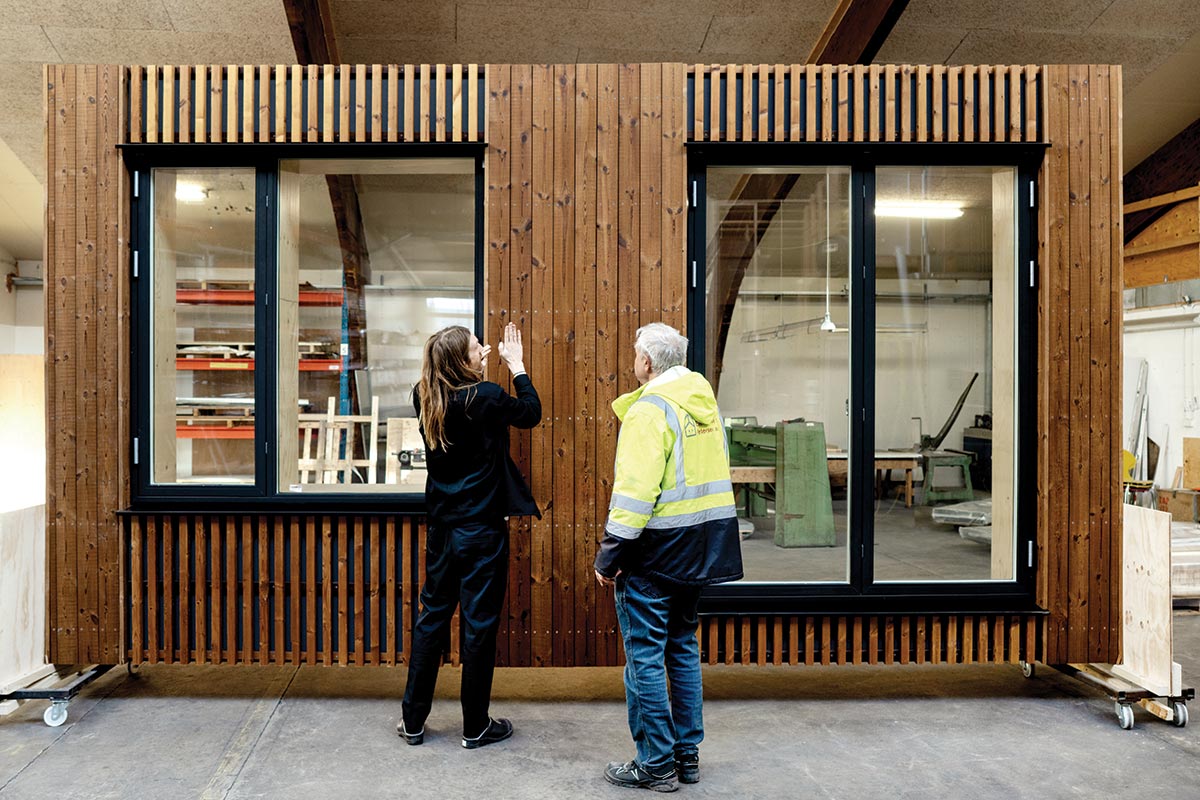Climate Justice
From resilient housing to handling heatwaves
Sponsored by Architectural Record and Construction Specialties | By Katharine Logan; James S. Russell, FAIA; Edward Mazria, FAIA; Jake Bittle; Matthew Marani; Joann Gonchar, FAIA; Pansy Schulman
View course on architecturalrecord.com »
While the environmental emergency is endangering the entire planet, its impacts are not equally shared but are far more threatening to poor nations globally and to marginalized communities in the U.S. In the pages ahead, RECORD explores these severe problems—and potential solutions—focusing on inequities in shelter, flood resilience, the peril of extreme heat, and public policy.

Photo courtesy of Mass Design Group
Rwanda Institute for Co¬nservation Agriculture, Bugesera
Crisis of Inequity
We are not all-in on the climate emergency—and coming together is the only way out.

Photo courtesy of Virginia Hanusik
Flooding overwhelmed Lake Verret in Louisiana in 2017.
The most recent report on environmental impacts, adaptations, and vulnerabilities from the United Nations’ Intergovernmental Panel on Climate Change, released in February, is “a further code red warning for humanity,” according to UN Secretary-General António Guterres. (Further code red: homo sapiens aren’t looking all that sapient right now.) The failures so far, either to meet greenhouse-gas-reduction targets or to adapt to predicted climate impacts, have left more than 3.3 billion people—that’s about half of the world’s population—“highly vulnerable” to floods, drought, heat, food shortages, wildfires, and associated economic and social strife. And because the climate crisis is a force multiplier that compounds pre-existing vulnerabilities, these impacts are not evenly distributed: as with Covid, the people who are already disadvantaged will continue to be the hardest hit.
The link between climate impacts and social inequities is what climate justice is about, and it’s a link that’s especially strong in the built environment. “Almost anywhere we look, the places architects practice have histories of injustice. We are literally building on these sites,” says Kian Goh, an associate professor of urban planning at UCLA Luskin School of Public Affairs and a faculty director of the school’s Institute on Inequality and Democracy. “A core part of our practice is to be accountable to the fact that these are not neutral places.”
In North America, place-based injustices include the dispossession of Indigenous people, exploitative labor practices in the construction of the fabric of our cities, the redlining of Black and immigrant communities (by banks to deny financing based on race), and the siting of toxic facilities next to communities of color, to name just some of the big ones. The legacies of these injustices, as they translate into climate vulnerabilities, are palpable. Even though redlining is now illegal, historically redlined neighborhoods still suffer from disinvestment and have, for example, fewer trees and green spaces than other parts of their cities: a study published in 2021 confirmed that census tracts whose residents are predominantly people of color are hotter in summer heat waves (with higher surface urban heat-island intensity—in some cases by more than 5 degrees Fahrenheit) than predominantly white areas in all but six of the 175 largest urbanized areas in the continental U.S. (page 98). Another study, cross-checking demographic information with nighttime-light data from satellites during last year’s winter power outages in Texas (a substantial amount of which were transmission disconnections and emergency load-shedding triggered by ERCOT, the grid operator), found minority-dominated neighborhoods were more than four times as likely to suffer a blackout than predominantly white areas.
How does the concept of climate justice connect these dots? According to researchers Sonja Klinsky and Anna Mavrogianni, in a special issue of the journal Buildings & Cities, the first dot is the fact that some countries around the world have contributed to (and benefited from) climate-change factors more than others. Of greenhouse gases emitted since the start of the industrial revolution, the U.S. alone is responsible for 26 percent, with the European Union responsible for another 23 percent; India, by contrast, despite having a much larger population, accounts for 3 percent, and even China has caused only 12 percent. Dots two and three are that climate impacts are unevenly distributed, as is the vulnerability to them. Whether it’s the case of the Marshall Islands sinking into the Pacific or of Indigenous land and culture almost completely eroded, with the rapidly shrinking Isle de Jean Charles, Louisiana (page 95), uneven climate impacts often trace pre-existing patterns of privilege and marginalization. The fourth dot is that the causes and effects of the climate emergency are often separated by time, space, and social strata, which complicates decision-making and accountability. Dot four, in particular, is the one for architects to watch.
A critical aspect of how systems of decision-making reinforce inequities depends on who is part of the process and whose voices are missing, says Idowu Jola Ajibade, an assistant professor at Portland State University, whose research focuses on climate change, urban sustainability, and societal transformation. Cities—with their factories and warehouses, railroads and ports
—were not necessarily built for low-income groups, she says: “They were built for wealth accumulation.” From that perspective, “you begin to get a sense of why the voices of low-income groups and people of color—the people who built the essential foundations of the cities of today—have been silenced.”

Photo courtesy of Audiohifi via Wikimedia Commons
The Richmond Chevron refinery in California sits in an area with a legacy of economic and environmental injustice.
Engaging marginalized communities in decision-making about their environment is a critical challenge of climate justice. And yet, “it’s a hurdle for many of us in professional practice and in academia,” says Goh. “These systems are steeped in class difference, and many of us do not come from the groups from which climate justice struggles emerged.” She suggests built-environment professionals need to be more attuned to injustices within our own ranks, as well as to the embodied struggles that have given rise to the climate-justice movement. Complicating the challenge is the fact that the localized nature of many community-based climate-justice initiatives is at odds with the scale and speed of change that’s required to mitigate the climate emergency. “So how do we not talk over or otherwise speak for these frontline vulnerable communities?” Goh asks. “And what practices can we embrace that take their claims for justice seriously, at the same time as we need to do big projects fast?”
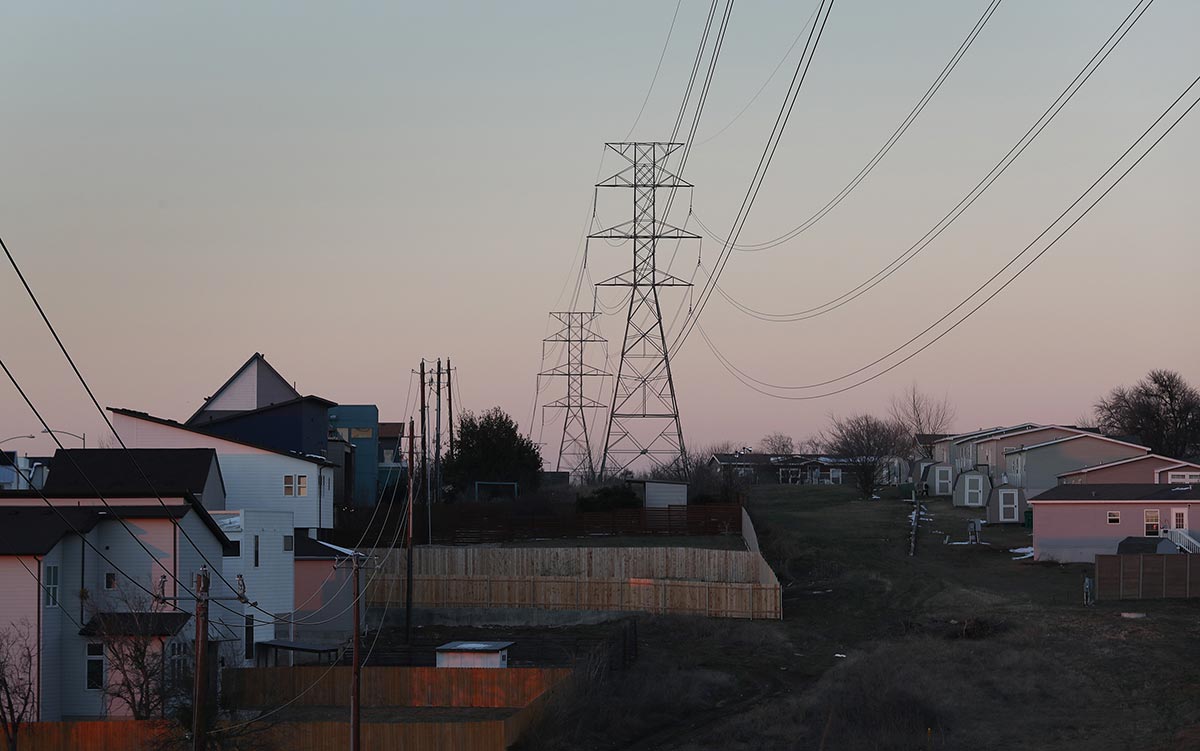
Photo courtesy of Joe Raedle/Getty Images
Minority-dominated neighborhoods in Texas were four times more likely to experience blackouts during the 2021 power-grid crisis than predominantly white areas.
These are questions that Mithun has been grappling with over the course of its five-year engagement with the community of North Richmond, in Contra Costa County, California (population: about 3,000). Bounded on all sides by industrial areas (including the Richmond Chevron Refinery, California’s largest source of industrial emissions), the formerly redlined community with few trees struggles with the heat-island effect, wildfire smoke, and noxious ground-level ozone from industrial pollutants, regular threats of inland flooding and coastal storm surges, and a housing crisis. Mithun first began working with North Richmond as part of the 2018 Resilient By Design (RbD) Bay Area Challenge, and is continuing to support the community in developing strategies for stability, home-ownership, and resilience that were initiated during that collaboration.
“We need to broaden the definition of “client” beyond real-estate firms or institutions, to include emerging community groups,” says Hilary Noll, an associate principal at Mithun. And the idea of being a “design-first” firm in this context is just wrong, she says: “We should first be showing up, listening, and accompanying communities as they build capacity.” Pre-development engagement with and support of local nonprofits have provided an essential foundation for a handful of projects that are now advancing in North Richmond, including an eco-village —with housing, an elementary school, and green space along Wildcat Creek (North Richmond’s only natural area)—and a horizontal levee to rehabilitate a stretch of the San Francisco Bay shoreline while protecting the community from rising sea levels.
Along with the RbD design phase, a community land trust called RichmondLAND was created to acquire property and work with nonprofit organizations to develop facilities that the community really needs. As a founding partner, Mithun has mentored the trust’s junior real-estate managers as they get up to speed on the fundamentals of running a project, and has helped make connections among community leaders, county and housing authority officials, and industry professionals. As a result, community-land-trust leaders recently advised the county housing authority on priorities—such as anti-displacement strategies—to be included in an RFP to acquire local HUD-owned lands. Backed by a team that includes an affordable-housing finance manager, a land-use attorney, and members of Engineers Without Borders, all of whom work pro bono (as does Mithun), a historically disempowered community is becoming increasingly effective in pursuing its objectives. For firms that worry they don’t have the capacity to foster climate justice for free, Noll says that 1 percent (the portion of revenues that Mithun dedicates to pro bono work) “really is just a drop in the bucket, but when applied carefully and thoughtfully, those resources can have a massive impact.”
Another firm that consistently prioritizes climate justice is MASS Design Group. “It’s in places that are poor or historically marginalized, or places that haven’t had as much access to resources, that we have to be aspirational,” says Alan Ricks, a founding principal and chief design officer at MASS. Referring especially to the firm’s work in Africa, Ricks describes the aspiration as “a relentless pursuit of progress that does not aspire to the same level as the West, but rather to bigger goals about being a model for the future.”
The most recent design in the firm’s portfolio exemplifying that theme is the Rwanda Institute for Conservation Agriculture (RICA), a 3,400-acre project aimed at improving food security in sub-Saharan Africa’s most densely populated country (with a population set to double again by 2050) by acknowledging the interdependence of human, animal, and ecological health. With an award-winning master plan, informed by an ecologist-generated map of what once lived and what could live on the site, the energy-independent campus stitches together remnants of savannah woodland and a lake, while at the same time demonstrating how nature and agriculture can coexist, and even become symbiotic. The campus buildings use low-carbon materials—stone foundations, earth walls, wood roof framing, and terra-cotta tiles—and 96 percent of them (by weight) were sourced within Rwanda. The work to regenerate the campus’s degraded land is expected to sequester enough carbon in the first 10 years to offset the embodied carbon of the complete development.
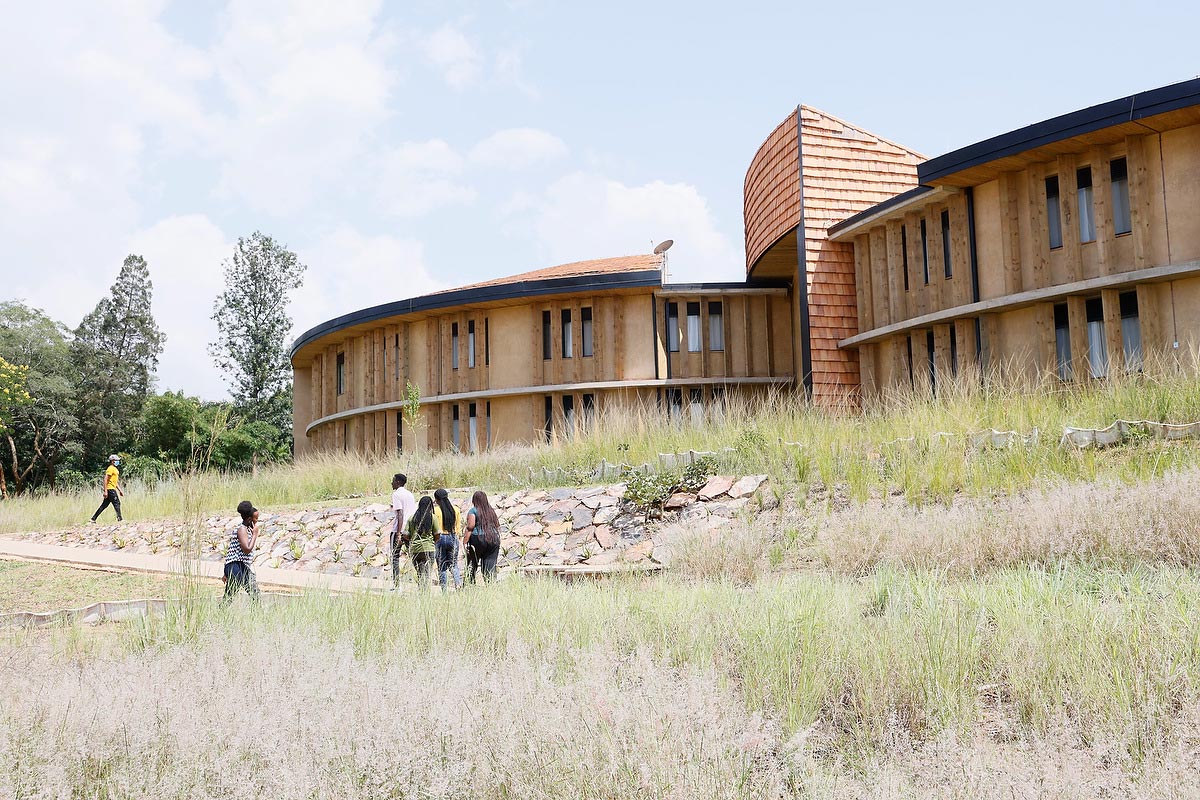
Photo courtesy of Iwan Baan
The Rwanda Institute for Conservation Agriculture, by MASS Design Group, regenerates its site’s degraded land.
It’s unusual for an architect to have as thorough an understanding of a project’s entire supply chain as MASS has had by necessity in Rwanda; taking greater responsibility for the climate impacts and social equity of materials and methods is a way Ricks sees that architects can contribute to climate justice. At the same time, he says, it’s unrealistic to put that responsibility on architects alone: “We need regulatory, political, social, and market pressures to demand these things, so that the appropriate amount of research and development can go into figuring out the answers.”
But the irrefutable truth is that every project, for better or worse, is a climate-impact project. And architects can take the opportunity—through the processes, as well as the projects they design—to support the people and places most at risk. “We are trained to find ways to build a better world,” says Goh. “If we can use our expertise—with space, with codes, with possibilities for change—to contribute to these movements for climate justice, that’s a really good start.”
Shelter from the Storm
Design firms and builders are fostering equity through innovation in affordable, climate-smart housing.

Photo courtesy of Phil Magakoe/AFP Via Getty Images
Recent flooding in South Africa damaged informal settlements the most.
A home is the basis of stability and security, the center of most people’s social, emotional, and even economic lives—a place where residents can live in peace, security, and dignity, according to the UN Special Rapporteur on the human right to adequate housing. Yet over the past decade, climate-fueled catastrophes have forced some 20 million people a year from their homes, becoming the primary driver of in-country migration. Low-income households are especially vulnerable, with a disproportionate number poorly housed in areas prone to storms, flooding, pollution, heatwaves, and drought. As RECORD goes to press, disastrous floods in South Africa have destroyed or damaged thousands of homes—many in informal settlements built in low-lying river valleys or on steep, unstable slopes—killing some 500 people and displacing thousands more. These calamities increase the burden on those least able to cope, making access to affordable, resilient housing an essential aspect of climate justice.
Fulfilling the human right to decent housing globally will take some innovation. The need for new housing around the world by the end of this century is predicted at 2 billion, but 2 billion times even modest carbon emissions from each home would amount to a giant step in the wrong direction. Tom Woodward, former climate lead in global policy and influence at Reall, an international housing development nonprofit, points to the link between the climate emergency and social justice in housing. “We cannot afford to address only one of these while making the other worse,” he says.
But solutions are emerging, combining materials innovation, off-site fabrication, and low-carbon design to advance equity in housing. In the Global South, where 90 percent of the world’s urban population growth is occurring, an increase of 2.5 billion is expected by 2050. Reall is backing climate-smart, affordable housing projects such as a mass-timber initiative in East Africa, zero-energy homes for disadvantaged families in Pakistan, and utility-scale solar with integrated housing in India and the Philippines, which exemplify key themes of climate justice. And in the Global North, where retrofitting is an imperative, both to increase livability and to reduce emissions, the affordable-housing sector is pioneering low- and high-rise solutions with transformative potential.

Photo courtesy of Borja Santurino/BuildX Studio
BuildX Studio is developing zero-carbon, prefabricated housing in Kenya.

Photo courtesy of Codrin Talaba
The Ken Soble Tower in Canada has been retrofitted to reduce its greenhouse-gas emissions.
To address housing demand from rapid urbanization without escalating embodied carbon, an initiative aimed at mitigating Kenya’s 2 million-home deficit (with a predicted need for 27 million units of new housing by 2050) is tackling the challenge at industrial scale. Leapfrogging lessons from the Global North, Nairobi-based design-build firm BuildX Studio and its partners are working to establish a sustainable, regional, mass-timber industry. With the goal of offering a zero-carbon, prefabricated housing option by 2030, the concept addresses the full value chain: coordinating a sustainable wood supply from neighboring Uganda; establishing the first cross-laminated timber (CLT) processing facility in Kenya; designing a flat-pack urban-housing system aimed at low- and middle-income brackets; prototyping; working with government to write new regulations; and building public awareness and acceptance of CLT as a replacement for steel and concrete. In addition to providing dignified, low-cost housing, the program has the potential both to transform Kenya’s construction industry and to create a new, high-value market for investments in carbon-sequestering forestry and its products. “BuildX is making a very long play,” says Woodward. “They’re not just thinking about buildings; they’re establishing a national-level supply chain for an affordable, zero-carbon solution that could actually work across the whole country.”
At the scale of low-income households needing secure shelter now, Karachi-based Open Door Design Studio, in collaboration with fabricator and sustainability consultant Modulus Tech, has designed factory-made, zero-energy homes that can be built for $10 per square foot, flat-packed 11 to a truck, and assembled without heavy equipment. Using a light-gauge steel structure, with insulated panel walls and a couple of cladding options, the 664-square-foot, two-bedroom homes (each with 256 square feet of courtyard and landscaped entry) achieve a carbon-footprint reduction of 90 percent, compared to a benchmark building. With average temperatures in the region predicted to exceed 120 degrees Fahrenheit by the end of the century, and air-conditioning both expensive and unreliable, “designing an elegant, climate-resilient home for people on a low income required a return to the basics,” says Currim Suteria, project architect at Open Door. “Building using passive techniques is the only way forward.” The project’s vernacular-derived cooling strategies, including courtyards and wind catchers (designed in collaboration with a doctoral student in wind engineering, Kimberley Adamek, at Western University in London, Ontario), can reduce interior temperatures by as much as 35 degrees Fahrenheit without air-conditioning. In addition to their cooling function, the courtyards admit indirect light, provide spaces for gathering, and offer views to greenery. The development team prioritized ownership by women and by people with disabilities (with mortgages costing about the same as they’d pay in rent in an informal settlement), significantly improving their security and that of their children.

Photo courtesy of Open Door Design Studio and Modulus Tech
In Pakistan, Open Door Design Studio and Modulus Tech have designed factory-made, zero-energy homes.
Where BuildX is tackling the issue of affordable, climate-smart housing through the supply chain, and Modulus is working at the building scale, Singapore-based climate tech venture Billion Bricks is tackling the problem with an ingenious paradigm flip. “They’re not building a house and putting a solar panel on the roof,” says Woodward. “They’re building a business plan for a solar farm in a place that has very high solar yield, and they’re integrating housing underneath it.” The housing enables the solar farm to provide a quicker return (from the sale of the homes) and the solar makes the 485- to 880-square-foot homes more affordable by providing an income stream to the homeowner. For example, a 10-kilowatt solar roof can generate as much as four times the energy that the home underneath it needs, a surplus that the homeowner can sell back to the grid or to a local factory. Billion Bricks has completed prototype homes in India and the Philippines, and is now looking to jump to the community scale. “They’ve looked at the problem and said, ‘There’s no way we can make a $10,000 house and yield a profit if we just follow conventional forms of building,’” says Woodward. “To address these problems, architects’ expertise needs to go beyond the conventional boundaries of what architecture is.”
In the Global North, meeting the need for affordable, climate-resilient housing also requires innovation in new construction, but even more crucial is retrofitting. With 80 percent of 2050’s housing stock already standing, decarbonizing it will have a greater impact than low-carbon new builds. What’s more, much of the social housing that was built in the mid-to-late 20th century—now a scarce resource—is starting to fail. Saving and upgrading it can be done for a much lower cost, both in terms of money and embodied carbon, than tearing it down and building new. In addition to improving the climate security and quality of life of low-income residents, retrofitting preserves the valuable social infrastructure that residents have built through their connections to their community.
An innovative, net zero–energy retrofitting strategy now being introduced in North America combines prefabrication and standardization to upgrade building envelopes and systems while allowing the homes to remain in use. Based on the Dutch-developed Energiesprong system, the strategy involves wrapping an existing building in a prefabricated high-performance envelope, and often integrates heating, cooling, ventilation, dehumidification, hot-water heating, and solar panels, to drastically reduce energy consumption. Using full-story prefabricated wall panels, retrofits can be completed in a week or two, or sometimes as little as a day, with no need for residents to move out. “Energiesprong is leapfrogging the incremental approach to energy efficiency that has been the norm and taking existing buildings all the way to fully decarbonized operation,” says Martha Campbell, a principal in the Rocky Mountain Institute’s (RMI’s) Carbon-Free Buildings program. “Their approach is ‘Let’s actually transform the construction sector,’ with business-model innovation to improve sector productivity and economies of scale to bring the cost of these high-performance systems down.” RMI’s REALIZE program has completed over-cladding pilot projects in Massachusetts and California, and a number of examples have also been built under the auspices of New York State’s Energy Research and Development Authority (NYSERDA).
Another over-cladding retrofit (this one not relying on prefabricated panels) is Ken Soble Tower, an 18-story, 146-unit seniors’ housing tower originally built in 1967 in Hamilton, Ontario. The tower is the first residential high-rise in North America to achieve the EnerPHit Certificate (the Passive House standard for retrofits). As a replicable proof of concept, the project serves as a major milestone in the work of saving and upgrading the period’s critical stock of purpose-built rental towers. Achieving a 94 percent reduction in greenhouse-gas emissions on an extremely tight budget, the holistic rehabilitation of the vacant, semi-derelict building included an EIFS (exterior insulation and finish system) rainscreen overcoat and triple-glazed windows, a new HVAC system, and quality-of-life upgrades such as interior refits, improved accessibility, and new indoor and outdoor common areas. The design adopted a comfort-first framework, prioritizing residents’ well-being, safety, and climate resilience, followed by having it require extremely low energy. “You don’t want to make a building more energy-efficient in a way that’s punitive for residents,” says Graeme Stewart, principal at ERA Architects, a firm that specializes in multiunit residential retrofits. (Stewart also heads the Toronto-based Centre for Urban Growth and Renewal, a research nonprofit that recently published A Field Guide to Retrofits in Occupied Buildings.)

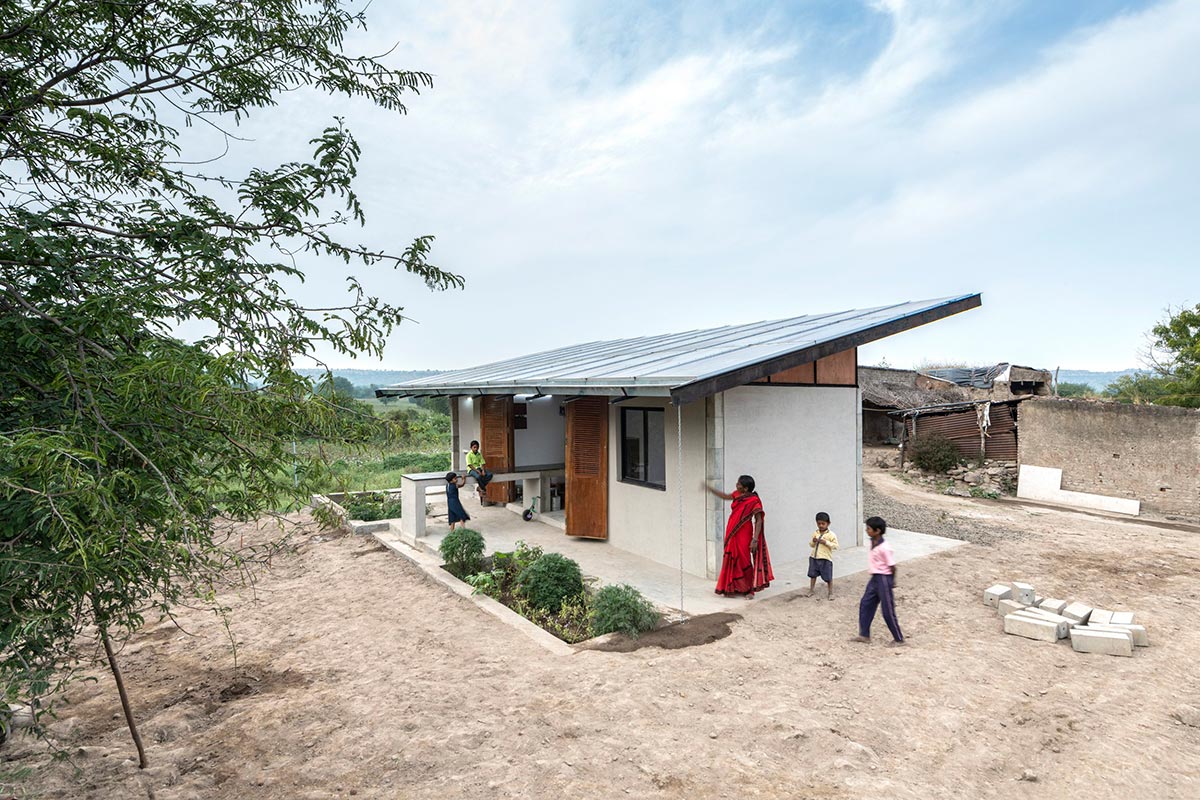
Photos courtesy of Photographix/Billion Bricks
Billion Bricks, a climate-tech venture, is building solar homes in India that provide income for their residents.
“The pandemic certainly validated the decision to provide direct fresh air,” he says, “and it also raised awareness of the inequality of conditions under which people had to shelter in place.” Completed in 2021, the project is now the focus of a long-term post-occupancy study by the University of Toronto, to measure multiple indicators of health, safety, housing quality, affordability, operational and economic factors, and environmental impacts.
The next challenge facing the developers of replicable prototypes—in North America and in rapidly urbanizing countries globally—is scaling up. Whether retrofitting or building new, the biggest issue, as usual, is funding. “If we’re going to address such a complex and fragmented system, we need more patient capital,” says Woodward, referring to investments that can wait longer than usual for a return. “We need time to accept risks and work through them.” Ultimately, climate-resilient housing for vulnerable people is a larger imperative, says RMI’s CampBell, and governments need to commit to it globally: “When you talk to people in defense and national security, climate risk is at the top of the list. With the level of geopolitical instability that it will spark, the volume of climate refugees that we’ll see, we need to stop nickling and diming this.” It’s time to start treating quality, climate-resilient housing as a necessity of life.
Equity Meets Resiliency
In Houston and New York, a range of strategies to address climate change is improving the urban realm and the quality of life for communities of different income levels
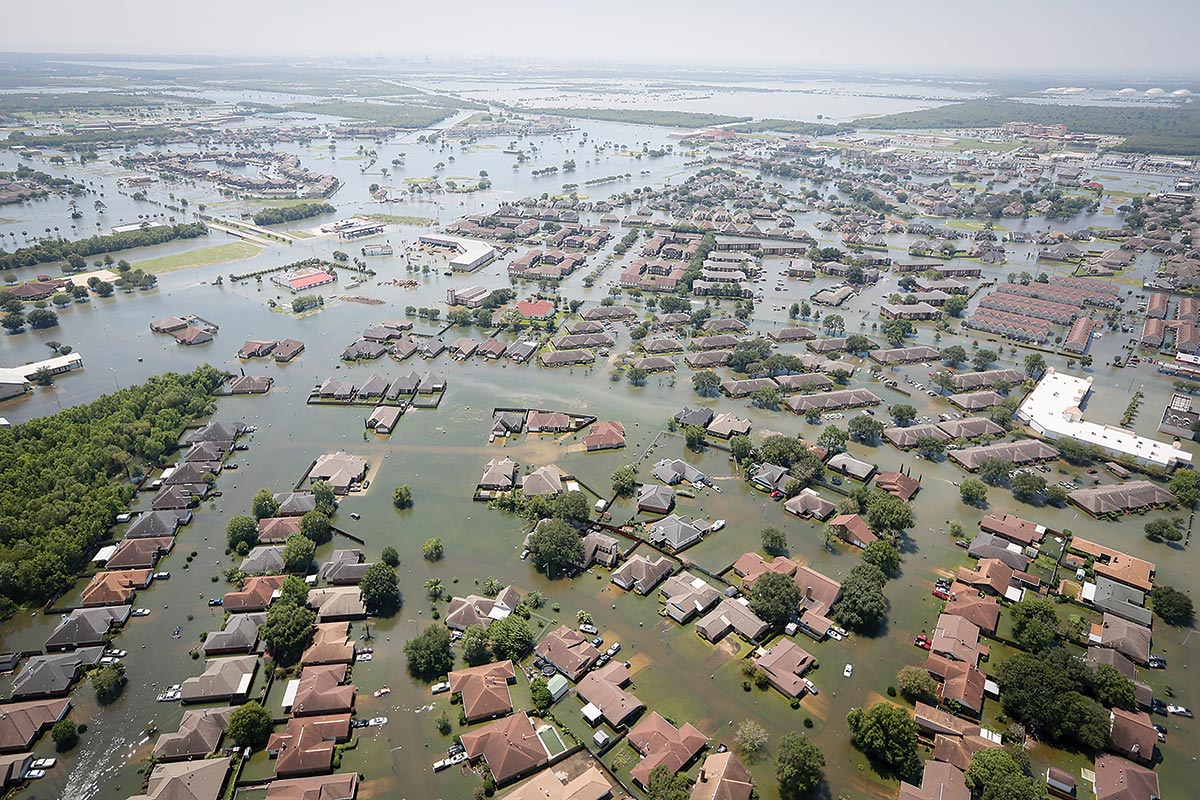
Photo courtesy of U.S. Air National Guard Wikimedia Commons/p>
Rising waters flooded Houston after Hurricane Harvey in 2017.
With disruptions and disasters supercharged by climate change now happening more frequently, resiliency—the business of protecting communities from threats, or adapting to them—becomes more urgent. After thousands of square miles of metro Houston were inundated by Hurricane Harvey in 2017, the city and Harris County implemented impressive large-scale and community-enhancing flood-management projects—yet they are not enough, and too often continue to fail the most vulnerable. At the coastal edge of New York, on the other hand, Arverne East has broken ground on a $1 billion mixed-use development that makes transformative leaps in sustainability and resiliency, while enhancing the economic and social viability of a struggling neighborhood.
Houston was particularly susceptible to the torrents that came with Hurricane Harvey—the worst downpour in Texas history, with 60 inches of rain in parts of the state. The city is nearly flat, heavily paved, and has soils that drain poorly: the storm left behind more than 150,000 flooded homes, including 25 percent of the city’s affordable stock, and caused $125 billion in damages. The area famously lacks land-use controls, and, so, over the years unfettered building had occurred in high-risk areas, many of which are low-income enclaves where people have fewer resources to deal with greater damage.
The Houston metro area has relied on an extensive bayou network that drains stormwater into Galveston Bay, but the system is no longer up to the task. Houstonians have also recognized the value of enhancing bayou habitats for recreation, along with flood management. After Harvey, the city, working with its nonprofit Parks Board and the Harris County Flood Control District, rushed to complete a Bayou Greenways 2020 initiative—to construct 150 miles of trails and 3,000 acres of parks, habitats, and flood-control enhancements across seven bayous and the West Fork of the San Jacinto River. Though the plan was still 50 miles short of its goal last year, it will eventually put 1.5 million Houstonians within 1.5 miles of a greenway.

Photo courtesy of Jonnu Singleton
SWA Group helped the Harris County Flood Control District create a series of interconnected man-made lakes in southwest Houston. Known as Willow Waterhole, they reduce flooding by storing excess stormwater.
Does the initiative equitably serve all neighborhoods? “These types of projects are often deployed opportunistically, connecting to existing trails, open space—or leveraging adjacent infrastructure projects,” explains Scott McCready, principal at landscape architecture firm SWA Group’s Houston office, who worked on the widely admired Buffalo Bayou Park in 2015 and on flood-resiliency for Harris County. That approach can result in already well-served areas’ seeing greater investment, but leaving needier neighborhoods behind, which McCready says “is an ongoing challenge to all involved.”
The Flood Control District has used government funding to buy private houses that have been repeatedly inundated, and demolish them. The program also has obtained large tracts (such as a golf course and industrial land) and excavated them to form waterways lined with pollutant-filtering plantings that have the capacity to store large water volumes during storms. Several are as big as or bigger than a 291-acre network of storm detention lakes designed by SWA. Called Willow Waterhole, the lakes are wrapped in habitat and threaded through with trails and bridges. Not incidentally, these add badly needed park acreage accessible to a wide variety of income groups.
The scale of such efforts is impressive, but so is the need within the 10,000 square miles of the metro area, as Houston spends less per capita on parks than almost any large city. McCready hopes a new park-board plan called Beyond the Bayous, which explicitly identifies equity as a goal, can connect the bayou landscapes to upland neighborhoods lacking green space, through “gateway” infiltration parks and bioswale-lined pedestrian and bike corridors.
The innovative and comprehensive approaches advocated by McCready confront an aversion in Texas to planning on a watershed or regional scale. Greater flood-protection investments are being delayed, for example, thanks to a controversy over the state’s distribution of $2 billion in federal dollars spread among outlying communities while none of the money was allocated to hard-hit and populous Houston and Harris County. A HUD probe showed the state’s actions “substantially and predictably disadvantaged minority residents, with particularly disparate outcomes for Black residents,” as reported by The Texas Tribune.
Given the urgency and extent of Houston’s problems, it could be easy to default to such known civil-engineering solutions as concrete-lined channels and enormous underground storage tanks. To expand this limited palette and develop benefits for more diverse communities, “we try to demonstrate with our work that people will get something new that they didn’t expect,” says McCready. Buffalo Bayou Park showed that a neglected, polluted waterway, winding among freeway overpasses, could become an urban amenity that draws visitors across the city to its paths, bikeways and attractions. The park, at the edge of downtown, has spurred adjacent development and solidified a consensus to create parklike amenities as flood protections are enhanced.
In the southeastern corner of Queens in New York, grass and shrub-covered dunes established themselves over decades on 116 neglected acres along the densely built-up ocean beaches of the Rockaway peninsula. The tract had once been bulldozed for an urban-renewal project that went nowhere.
But now a real-estate team—L+M Development Partners, the Bluestone Organization, and Triangle Equities—led by the New York City Department of Housing Preservation and Development has broken ground on Arverne East, a mixed-use, ocean-facing community that is deploying a comprehensive sustainability and climate-resiliency agenda, while bringing sorely needed affordable housing and economic development opportunities to a diverse low-income neighborhood vulnerable to storm surges and rising seas.
The $1 billion project will achieve net zero operating carbon. The mixed-use master plan, by Local Office Landscape and Urban Design (LOLA), Bernheimer Architecture, and landscape architects Starr Whitehouse, places the highest-density housing farthest from the ocean and adjacent to an arterial road and an elevated subway stop


Photos courtesy of Jonnu Singleton
Hurricane Sandy in 2012 caused extensive damage in the Rockaways in New York, helping to spur new approaches to resilient development, including projects like Arverne East, which will provide 1,350 below-market-rate homes and achieve net zero operating carbon.
The baseline of the development has been raised 16 feet higher than a mapped but obsolete flood-elevation standard, and the scale of the development steps down to townhouses and then tiny attached houses, as small as 400 square feet, that emulate the little beach bungalows with front porches characteristic of the neighborhood. Of the 1,650 total units planned, all but 300 will be offered below market rate to buyers and renters ranging from the formerly homeless to those of low, moderate, and middle income. The tiny cottages—unique in new construction—add affordable ownership to the mix, an effort to “hack the market,” says Walter Meyer, principal of LOLA.
The development will achieve its zero-carbon goals with tactics that adhere to the Passive House standard and include a geothermal heating and cooling system, and photovoltaic solar panels.
Meyer’s LOLA has designed enhancements to the natural dune system to protect the development. The scheme deploys interlocking rows of sand ridges to minimize storm surges and dissipate wave energy, alternating with swales that store and infiltrate flood waters and that host trees and shrubs to help anchor the beach and slow high winds.
Since heavy rainfalls usually coincide with tropical storms, bioretention networks threaded through the development will harvest the runoff from adjacent and internal streets, storing excess water and infiltrating it when existing underground storm drainpipes are likely to be inundated. These nature-based tactics will manage rainfall from a 100-year storm, 10 times the current standard.
In a consultation process, residents of the community sought economic development and entrepreneurship opportunities, and the development plan has brought local players and social services groups into the project. The Rockaway Brewing Company, a beloved gathering place, will relocate to Arverne East and expand to host an incubator for aspiring cooks, who will make use of fresh produce grown on urban farms nearby. On-site, a farm plot will be set up by the Campaign for Hunger, an organization that helps communities secure healthy food options. Another nonprofit, RISE, will expand its youth-development activities and environmental-education programs at the project.
The development team proved the financial efficacy of its resiliency and sustainability concepts by deploying them in a three-building development on an adjacent site called beach green dune. With the success of this pilot project, says Meyer, “The developers and lenders gained faith that they could be scaled up in Arverne East.” And self-seeding nature lives on too, with 35 acres of the site dedicated as an enhanced public preserve.
Fight or Flight?
After disaster strikes, communities must grapple with the question of rebuilding or relocating

Photo courtesy of Josh Haner/The New York Times/Redux
Isle de Jean Charles, Louisiana, shown in 2016, has lost 90 percent of its landmass due to sea-level rise.
In the aftermath of Hurricane Sandy in 2012, the residents of Oakwood Beach, on the south shore of Staten Island, made a momentous decision. The neighborhood, in New York’s least dense borough, had experienced flooding before, but this hurricane had all but wiped it off the map, and many residents weren’t sure they wanted to risk rebuilding. A group of locals petitioned the state government to buy out and demolish their houses, using money from the federal Department of Housing and Urban Development, and within three years almost the whole community had signed on—around 180 homeowners in all. A decade after the storm, the land has begun to revert to nature, transforming back into the untrammeled wetland it once was. By the time the next storm comes, there will be no homes left to destroy.
As climate disasters grow more severe with each passing year, and as the federal government spends hundreds of millions of dollars to help adapt to these disasters, some communities in the United States have begun to consider the notion of “managed retreat,” or the coordinated movement away from the most vulnerable areas. Instead of armoring themselves against storms and fires, these communities are choosing to get out of the way altogether, surrendering their old homes to nature and relocating elsewhere.
This movement is still in its infancy, confined to small communities on the fringes of the natural environment, but soon many more towns and cities in the United States will be forced to confront the same decision as the residents of Oakwood Beach, and, for many communities, these decisions will be agonizing. Managed retreat can save lives and money and can help undo the past mistakes of planners and developers, but it also raises deep questions about people’s autonomy, sense of community, and environmental justice. If not every neighborhood or town can stay put, who decides which must leave?


Photos courtesy of Robin Michals
Nature is reasserting itself at Oakwood Beach on Staten Island after many houses were flooded out.
“Everyone agrees that they want [relocation] to be fair, and they want it to be just, but no one agrees on what that means,” says A.R. Siders, a professor at the University of Delaware who has studied managed retreat and its implications for environmental justice. “How do you define a community? And how do you handle dissent within a community? We’re very good at pointing out the injustices after they happen, but we really struggle with getting good guidance on doing this.”
The first managed-retreat efforts in the United States came about almost by accident, as the result of a shift in disaster policy. Faced with the mounting costs of severe flooding along rivers like the Mississippi, Congress in the 1990s authorized FEMA to buy and demolish properties that had been inundated rather than paying their owners to rebuild them. The agency has bought out more than 40,000 properties after disasters—like a 2014 mud slide in Washington state and 2017’s Hurricane Harvey in Houston—since then. Several cities, including Charlotte and Nashville, have developed their own local buyout programs as well.
While the federal buyout program was designed to save FEMA from paying to rebuild the same places over and over again, it now has come to alter built environments around the country, erasing whole communities and allowing nature to return. Because the program is voluntary, and localities can’t force residents to leave unless their officials pursue eminent domain, buyouts look very different in different parts of the country. In New Jersey, for instance, the state’s Blue Acres buyout program uses FEMA money to buy out population pockets where residents already have decided to leave after repeated flooding. In other communities, such as the northwest suburbs of Houston, near the White Oak Bayou, the county government bought out properties with FEMA money and now pays to maintain the empty lots, mowing the grass at regular intervals for the sake of the handful of homeowners who chose to stay behind.
Nevertheless, not every buyout has achieved community support. In the city of Kinston, North Carolina, the FEMA program led to the destruction of a historic Black neighborhood called Lincoln City with decades of history; the community was flooded by Hurricane Floyd in 1999, after which the city decided to buy it out rather than rebuild. Once a vibrant working-class community, the abandoned tracts of the neighborhood have disintegrated, returning to forests and swamps.
“It was community, it was family, it was love—everybody knew everybody, everybody stood in the gap for everybody,” says Eartha Mumford, a former resident of the neighborhood. After the storm, she said, Lincoln City residents “wanted to keep a hold on their property and go back in there, hoping we could do something with it. Then the city jumped in and they just took over.” Mumford, who now lives a few towns over, drives to the old neighborhood every so often to say hello to the few families who still live on the outskirts. Lincoln City’s fate matches the trends that Siders identified in her study of climate adaptation in North Carolina as a whole. Siders found that wealthy white communities tend to receive more money for sea walls and other flood protections, while low-income communities of color were more likely to see buyouts and managed retreat.
In other cases, communities have relocated in their entirety to land on higher ground, rather than scattering to wherever they can find available housing. The most famous instance is Isle de Jean Charles, Louisiana, an island village long inhabited by Biloxi-Chitimacha-Choctaw Indigenous Americans, which has lost more than 90 percent of its landmass to sea-level rise, shrinking from 22,000 acres down to a few hundred. Most of the southeast Louisiana coastline now sits inside a levee system built by the U.S. Army Corps of Engineers that protects it from storm surge, but the federal government did not extend the levee around Isle de Jean Charles. Instead, it paid the state to build a new village 20 miles inland and relocate the island’s residents. But, from the very beginning, this program was controversial: while the new community offers bigger houses and more protection from storms, it’s almost an hour from the Gulf of Mexico, depriving the island’s former residents of their livelihoods and traditions as shrimpers and crabbers. When completed, the new district will comprise about 500 houses, plus a community center.
Other examples of whole-community retreat include a riverside town in Wisconsin that reinvented itself as a “solar village,” with buildings’ incorporating passive solar strategies; the relocation was a success, but it only involved a few dozen structures. A series of Indigenous communities in Alaska have sought money to move away from eroding shorelines, but their relocation projects have been hampered by funding delays and prolonged negotiations among residents. Even in places where everyone wants to move, it’s difficult to achieve these relocations on a large scale: moving a whole town is far more expensive than buying out individual homeowners, and it requires long-term commitment from an entire community.


Photos courtesy of Kael Alford, Isle de Jean Charles Resettlement Program, Louisiana Office of Community Development
In the wake of flooding that repeatedly overwhelmed Isle de Jean Charles, as it did after Hurricane Gustav in 2008, the state decided to build a new village 20 miles inland.
In Isle de Jean Charles, no less than on Staten Island, managed retreat provides one permanent solution to a perennial problem—needing to move people out of harm’s way—thus saving the government hundreds of millions of dollars in the future. But that doesn’t always make it just. The residents of Oakwood Beach wanted to leave, but many longtime denizens of Isle de Jean Charles wanted to stay on their ancestral island, no matter the cost, and viewed the government’s decision not to extend the levee around them as a manifest injustice.
“You solve part of it by increasing the pot of available money,” says Siders, adding that the government must spend far more on climate adaptation than it currently does. In addition, though, she says the federal government needs to take “a more holistic approach, and increase coordination” between agencies and local community leaders. The decision not to put a wall around Isle de Jean Charles didn’t happen at the same time as the solution to relocate the tribe—but it should have.
For communities on the front lines of climate change, the dilemma of deciding between staying or leaving raises wrenching questions. Who should have the ultimate say about the fate of these places—the federal or local government or those actually under siege by rising waters? What if the residents don’t agree among themselves? Who gets to decide which communities will try to stay? Or disperse? Or move in their entirety?
The answers to these questions are still far from clear, but the questions themselves are not going away.
Jake Bittle, is a reporter based in Brooklyn. His book on climate migration will be published by Simon & Schuster in early 2023.
The Human Cost
Heat waves are a serious urban killer. Boston’s new plan tackles the problem while addressing inequity

Photo courtesy of City of Boston and Sasaki
A “cool spot” pop-up offered shade outside an East Boston library branch in 2021.
Extreme heat is an ever-growing threat to human health and well-being, one that has been exacerbated by global warming. Those soaring highs, associated with the greenhouse-gas emissions generated by our industrialized world, have increased the earth’s average temperature by 1.2 degrees Celsius since the late 19th century. However, the specter of rising temperatures is not evenly distributed geographically and disproportionately affects the Global South—the very regions that were exploited to fuel the industrial economies of the West. It is now estimated that nearly 40 percent of deaths resulting from heat exposure over the last three decades derive from human-made global warming, with much of that suffering inflicted on Africa, South Asia, Central and South America, and the Mediterranean Rim.
North America is also grappling with extreme heat conditions, as even formerly moderate regions, such as the Pacific Northwest, experience searing summer heat waves. In Portland, Oregon, for example, temperatures reached nearly 120 degrees Fahrenheit last summer, resulting in a spike in deaths and the failure of infrastructure. Such issues are further compounded by the continued legacies of urban disinvestment, where certain communities, often poor and of color, are subject to higher sustained temperatures due to the urban heat-island effect—in short, an abundance of heat-retaining surfaces and a dearth of vegetation.
The threat is growing in real time, and cities like Boston, where the number of days over 90 degrees Fahrenheit is expected to grow from an average of 10 days per year to nearly 50 by 2070, are grappling with those life-threatening conditions. But now, under the recently inaugurated administration of mayor Michelle Wu, Boston has started rolling out a new framework. Its Heat Resilience Solutions for Boston, more commonly known as the Heat Plan, is the collaborative product of a team of consultants led by Boston-based Sasaki. The plan presents 26 strategies to ameliorate heat conditions, and focuses on five of the city’s hottest neighborhoods: Chinatown, Dorchester, East Boston, Mattapan, and Roxbury. These predominantly low-income and majority-minority communities have long suffered from the ill effects of redlining and urban renewal, and, on average, are 7.5 degrees Fahrenheit warmer during the day than Boston’s more affluent and tree-canopied neighborhoods.
The Heat Plan follows a nearly decade-long collaboration between Sasaki and the City of Boston and is a new and critical component of the Climate Ready Boston initiative, which seeks to address the short- and long-term effects of climate change, such as sea-level rise and extreme precipitation. “This is the first time that Boston has done a citywide heat-resilience plan, and it is taking that same focus as our earlier work trying to understand how investments in climate resilience can help create a more equitable urban environment,” says Sasaki associate principal Jill Allen Dixon. “A big focus has been how to approach heat resilience from the angle of social equity and racial justice, acknowledging the harms of the past while also being better planners as we move forward.”

Photo courtesy of Sasaki
The Heat Plan’s air-temperature maps are based on data gathered during a weeklong analysis period in July 2019, which corresponded with a heat wave.
What does the plan look like on the ground? The 26 strategies outlined in the report are broken down into two categories: relief during heat waves and longer-term cooling of communities. The development of the strategies depended on a series of neighborhood workshops, often conducted with the help of interpreters. “We really approached this from listening to people’s stories and reaching out to people where they are,” says Sasaki director of sustainability and resilience Tamar Warburg.
That deliberative process was supported by heat, land-use, and demographic analyses, which informed recommendations specific to individual neighborhoods. In the short term, the Heat Plan calls for several policy and physical interventions. The administration will first create the Boston Extreme Temperatures Response Task Force, an interdepartmental group that will coordinate with a wide range of stakeholders to best deliver resources and inform strategic actions. During heat waves, the plan outlines the rollout and expansion of the city’s network of air-conditioned cooling centers to include community organizations; greater utilization of public outdoor spaces for tot sprays, pools, and other forms of relief; and pop-up outdoor cooling kits that include misted tents, for summer public events. The Boston Extreme Temperature Response Task Force will also collaborate with public-education channels, and other public, private, and civic organizations, to educate Boston residents on heat resilience. Furthermore, the Task Force will facilitate fan and air conditioner giveaways, and amplify information regarding utility assistance.
Longer-term mitigation strategies are more capital-intensive. At the building level, the plan seeks to provide funding and technical guidance for energy retrofits and other interventions, such as a cool-roofs program that aims to replace dark-colored roofs with sun-reflecting light-colored materials, and the installation of green, planted roofs. In collaboration with the existing Urban Forest Plan, which has budgeted $500,000 to hire an arborist and the planting of 2,000 trees annually, the Heat Plan aims to expand Boston’s tree canopy and vegetated space in both the public and private realms through, say, new planting in parks and public rights-of-way, as well as the acquisition of privately owned land for conversion into open space. At the level of zoning and conveying permits, the plan calls for the incorporation of temperature analysis, alongside wind and shadow analyses, into the new development-review process, and the potential use of overlay districts or zoning adjustments to ameliorate urban heat islands.
Boston’s new mayoral administration is putting its money where its mouth is, and its first proposed budget places the city firmly as a leader in the Green New Deal movement, with nearly $200 million related to the objectives of the Heat Plan. Although the plan is particular to the City of Boston, its community-centric approach and comprehensive implementation process can be emulated in cities across the country. “We are experiencing an incredible moment of increased awareness of the impact that climate change has had on our lives, and the Covid-19 pandemic has additionally established a newfound appreciation for and willingness to invest in the public realm,” says Warburg. “These cultural shifts will lead people to seek models like Boston’s heat resilience strategies and explore how they can be adapted in their own communities.”
Matthew Marani, writes about architecture and urban design and is studying city and regional planning at Pratt Institute.
Making It Right
Federal and local governments take on carbon emissions and a long legacy of racial and social inequities
The research is sobering, but not surprising. The data tell us that communities of color are on the front lines of the environmental emergency. In the United States, racial and ethnic minorities are more than two times as likely as white populations to live with air pollution levels above the 90th percentile. In almost all large U.S. cities, the average person of color lives in a census tract with a higher surface urban heat-island intensity than those that are predominantly white, and those neighborhoods are also 50 percent more vulnerable to wildfire than those of majority-white residents. And, while property loss due to flooding disproportionately impacts poor white communities, scientists predict that, by 2050, increased flood risk will disproportionately affect Black communities. This racial divide only threatens to widen as the climate crisis accelerates.
But, as the world heats up, environmental leaders, community activists, and policy makers are working to create funding programs to address these inequities while decarbonizing the built environment.
One federal program that could help reverse a legacy of environmental neglect is Justice40, part of President Biden’s January 2021 executive order “on tackling the climate crisis at home and abroad.” It commits to delivering to underserved communities at least 40 percent of federal investments in climate, clean energy, affordable and sustainable housing, and other areas.
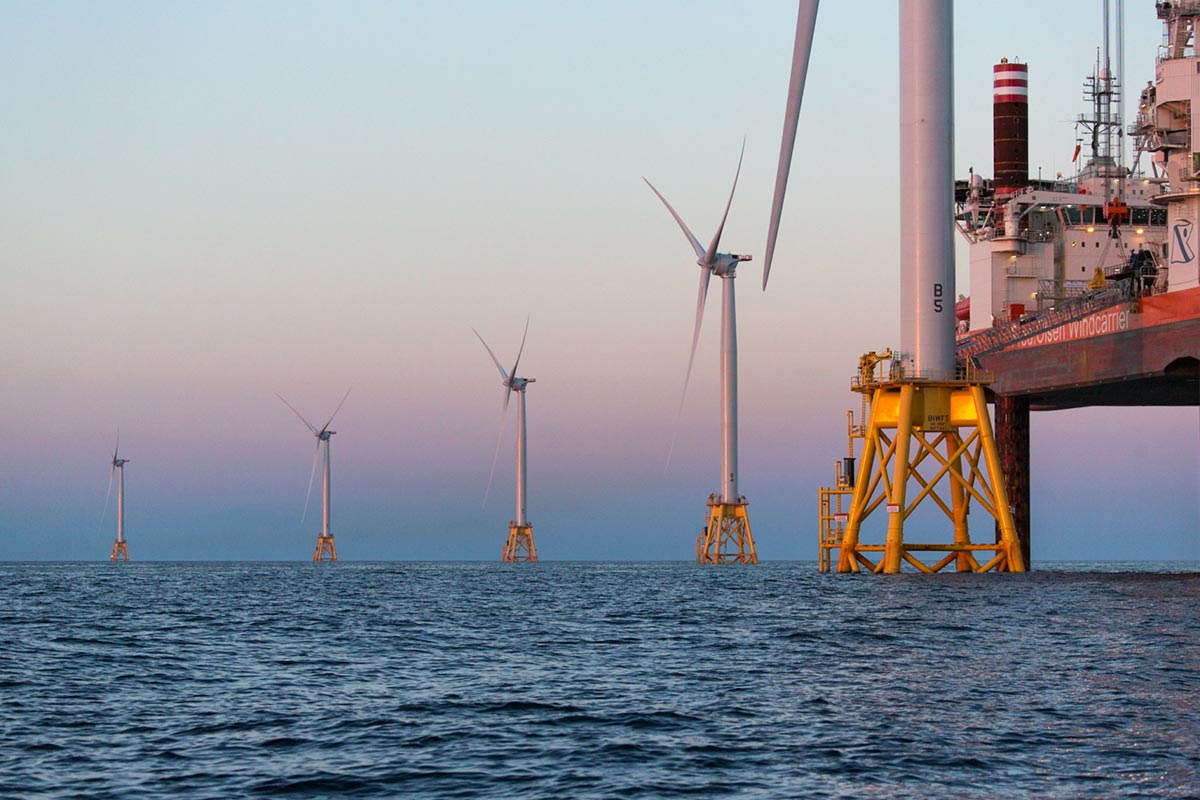
Photo courtesy of Joan Sullivan
As the nation’s grid becomes increasingly cleaner, with a growing share of energy coming from renewable sources such as wind, many localities are turning to building electrification to lower carbon emissions.
Agencies will be able to identify communities to target with a screening tool now in development, using such data points as household income, education level, life expectancy, and the presence of health hazards like lead paint or nearby superfund sites. Race, however, is not a criterion, despite Biden’s campaign promises to address the environmental burdens borne by communities of color. As numerous news outlets have reported, the color-blind approach is intended to avoid legal and political challenges. But some advocates worry the strategy will leave out the very people the program is intended to help. “The research tells us that pollution corresponds with race more than income,” says Dana Johnson, senior director of strategy and federal policy in the Washington, D.C., office of WE ACT, an environmental-justice group. “It is difficult to solve a race-based problem without acknowledging race.” She also worries that because Justice40 was created by executive order rather than legislation, it can easily be undone by a future administration. That is why, she says, getting the funding processes in place is so critically important.
Still, if Justice40 works as intended, it could radically alter how federal dollars are distributed. “We are changing how the federal government operates,” says Mark Chambers, senior director of building emissions and community resilience at the White House Council on Environmental Quality. “We are changing its DNA.”
Some cities, too, are creating their own programs and funding for battling climate change and inequity. Ithaca, New York, with 31,000 residents, has a bold plan to electrify all its buildings by 2030, approved by its Common Council last November. It will retrofit about 6,000 public, private, residential, and commercial structures so that they no longer rely on natural gas, propane, or fuel oil for space- or water-heating, or cooking. The work will be performed along with such energy-saving measures as replacing windows, improving insulation and air sealing, to make the building stock—80 percent was constructed before 1940—more efficient.

Photo courtesy of Christian Phillips, Courtesy Sasaki
By 2030, Ithaca, New York, plans to decarbonize all of its building stock, 80 percent of which was constructed before 1940.
Other U.S. cities are turning to electrification as a carbon-cutting strategy, as the grid becomes cleaner and electric appliances more efficient. Berkeley, California, jump-started the electrification movement in July 2019, banning gas connections in new small and midsize residential buildings. Since then, 77 jurisdictions across the country have instituted so-called “gas bans,” including the most populous city—New York. (Electrification has become such a trend that many states with Republican-controlled legislatures, where the fossil-fuel interests are strong, have rebelled and passed so-called “pre-emption laws” that prohibit cities from instituting gas bans.)
These building-electrification policies aim to affect health as well as reduce carbon. According to research from MIT, in 2018, combustion emissions from the buildings sector was the most significant cause of air pollution–associated premature deaths (in 2005 it was fourth, behind vehicle emissions, electricity generation, and industry). Meanwhile, a study by the Rocky Mountain Institute (RMI) and its collaborators found that levels of nitrogen dioxide—a gas associated with learning deficits and increased risk of asthma—were 50 to 400 percent higher in homes with gas ranges, not electric stoves. “Improved air quality is the biggest benefit of electrification for our communities,” says Annie Carforo, WE ACT’s climate-justice campaign coordinator. Electrification, its supporters say, is not more expensive. An RMI study found that, in most new-construction scenarios, electrification reduces costs over the lifetime of appliances compared with fossil fuels.
With so many cities adopting electrification policies, Ithaca may not seem so notable. But it is the first to focus on existing buildings rather than just all-electric new ones. The initiative includes creating a “green jobs corridor” in conjunction with nearby cities. Apprenticeship programs will be geared toward groups with high unemployment or underemployment, including members of tribal nations and the formerly incarcerated, says Luis Aguirre-Torres, Ithaca’s director of sustainability. Financing will come from private equity, providing low-cost loans to property owners, which they will pay back through energy savings. The city has already secured $250 million in capital—about half of what will be required to retrofit all 6,000 buildings, he says. The program appeals to investors interested in social impact, says Keith Kinch, a cofounder of BlocPower, the Brooklyn-based climate technology company that will manage the program.
Portland, Oregon, is financing a climate justice program through a 1 percent surcharge on large retailers. Established in 2018 via a ballot measure approved by 65 percent of voters, the Portland Clean Energy Community Benefits Fund (PCEF) was devised with the help of a coalition of Portlanders of color, faith-based organizations, and labor and environmental groups. PCEF, which will fund clean-energy, green-infrastructure, regenerative-agriculture, and workforce development, “is fundamentally about addressing climate change and a community that has been excluded to date,” says Sam Baraso, its program manager.
The inaugural round of grants last year awarded $8.6 million to 45 projects that are estimated to achieve a savings of 11,500 metric tons of carbon. They include installation of rooftop solar on low- to moderate-income households of color, deep energy retrofits to Black-owned homes, and the replacement of impervious paving with native landscaping and shade trees at two schools with majority BIPOC student populations. Baraso expects to award the second set of grants, totaling $60 million, this summer.
Initially projected to generate between $44 million and $61 million annually, the retailer surcharge brought in $116 million in FY 2020–21 alone. But along with this influx of cash has come controversy. Earlier this year, the city council voted to rescind one grant after a local paper brought to light that the director of the recipient nonprofit had been convicted of fraud. She has subsequently sued the city. Then, the Portland Business Alliance called for a freeze on disbursing funds after the City Auditor’s Office recommended the PCEF re-evaluate its oversight, set a timeframe for completing a workforce-equity plan, and create guidelines to assist young nonprofits, among other improvements.
Baraso declines to comment on pending litigation but says that the audit results are entirely what one would expect for such a new and ambitious program. Many changes are already under way, he says, including structured support for less established nonprofits. “We can continue to implement the recommendations while moving forward with the next cohort of projects.”
Given the magnitude of the environmental-justice problem and the urgency of the climate crisis, forging ahead with such innovative local and national funding models may well be the most practical option. The same old financing formulas won’t achieve building decarbonization or address equity on the scale or with the speed needed. The innovative thinking behind strategies like PCEF, Ithaca’s electrification plan, and the federal government’s Justice40 could be our last and best chance for creating a low-carbon future in America.
The Renewables Gambit
A proposition: Putin loses, the West unites, and the movement to kick our fossil-fuel habit pays off

Photo courtesy of Ted Wood
Coal-fired power plants, like this one near Fruitland, New Mexico, could soon be a thing of the past.
The russian invasion of Ukraine has generated the headlines of the fossil-fuel industry’s dreams, with articles claiming that the transition to green energy will be more difficult, or that the 1.5-degree goal is all but dead—or even calling for more drilling and fossil-fuel development. But these assessments are clouding the extraordinary progress currently taking place worldwide: the development of sustainable, resilient, and zero-carbon built environments; and the unprecedented and explosive growth of renewable-energy generation, a promising solution for both ecological and political stability in the 21st century.
Nowhere are these achievements more evident than in the statistics coming from the solar and wind industries. Solar electricity generation is now growing exponentially worldwide, doubling between 2016 and 2019, and doubling again by 2021. Wind electricity generation is following a similar trajectory, doubling between 2016 and 2021.
In the U.S., solar and wind electricity generation is growing at an impressive rate as well. Solar electricity generation doubled between 2015 and 2017, and again by 2021. Wind generation doubled between 2010 and 2015, and again by 2021. So why do we think it’s so difficult to accelerate this growth, and address both climate change and energy security?
We are accustomed to thinking of growth and change in linear terms, because that’s what we’re most familiar with: a child growing about 2½ inches a year, for example, or a car rental billed at a fixed daily rate or per mile traveled. We’re not used to exponential growth—very gradual growth followed by an explosive increase over a very short period—and, as a result, we tend to underestimate it. Consider the lesson of the following legend: a clever courtier presented a beautiful chessboard to his king and requested in return one grain of rice for the first square of the chessboard, two grains for the second square, four for the third, eight for the fourth, and so on, with each square having double the number of grains as the square before.
The king agreed to what he thought was a modest request, only to discover that he had promised to deliver more rice than he had in his storerooms. The fifth square required 16 grains, the 15th 16,348, the 40th a million million, and so on—so his entire supply would be exhausted long before he reached the 64th square.
Wind and solar energy are now the cheapest sources of electricity generation for much of the world, and they continue to become cheaper each year—between 2010 and 2019, the unit cost of solar energy decreased 85 percent, and that of wind energy decreased 55 percent. The cost of lithium-ion batteries, essential for storing renewable energy that is generated at variable rates, also fell by 85 percent. With such quick progress, the remarkable solar and wind growth numbers are not unfathomable. And—with market forces, increasing pressure for energy security, and the implementation of emissions-reduction plans by governments and institutions, including incentives for sustainable development and electrification policies—explosive growth will continue to be the norm.
The price of fossil-fuel-generated power depends on the cost of plant construction and operations, geopolitics, and the respective prices of fuel, storage, and transportation. Solar- and wind-generated power, on the other hand, are very different: their fuel sources (sunlight and wind) are delivered free worldwide; they are not encumbered by fuel supply-chain issues; their installation and operating costs are comparatively low; and they require minimal rare earths or other difficult-to-obtain materials.
Today, 40.2 percent of the global power sector is supplied by zero-carbon-generated energy, with renewables—wind, solar, geothermal, and hydropower—making up three-quarters of the supply. If solar and wind sustain their present course of exponential growth, 60 to 75 percent of global power will be generated by renewables in 2030, and we will be able to phase out carbon dioxide emissions and transition to a zero-carbon power sector by 2040.
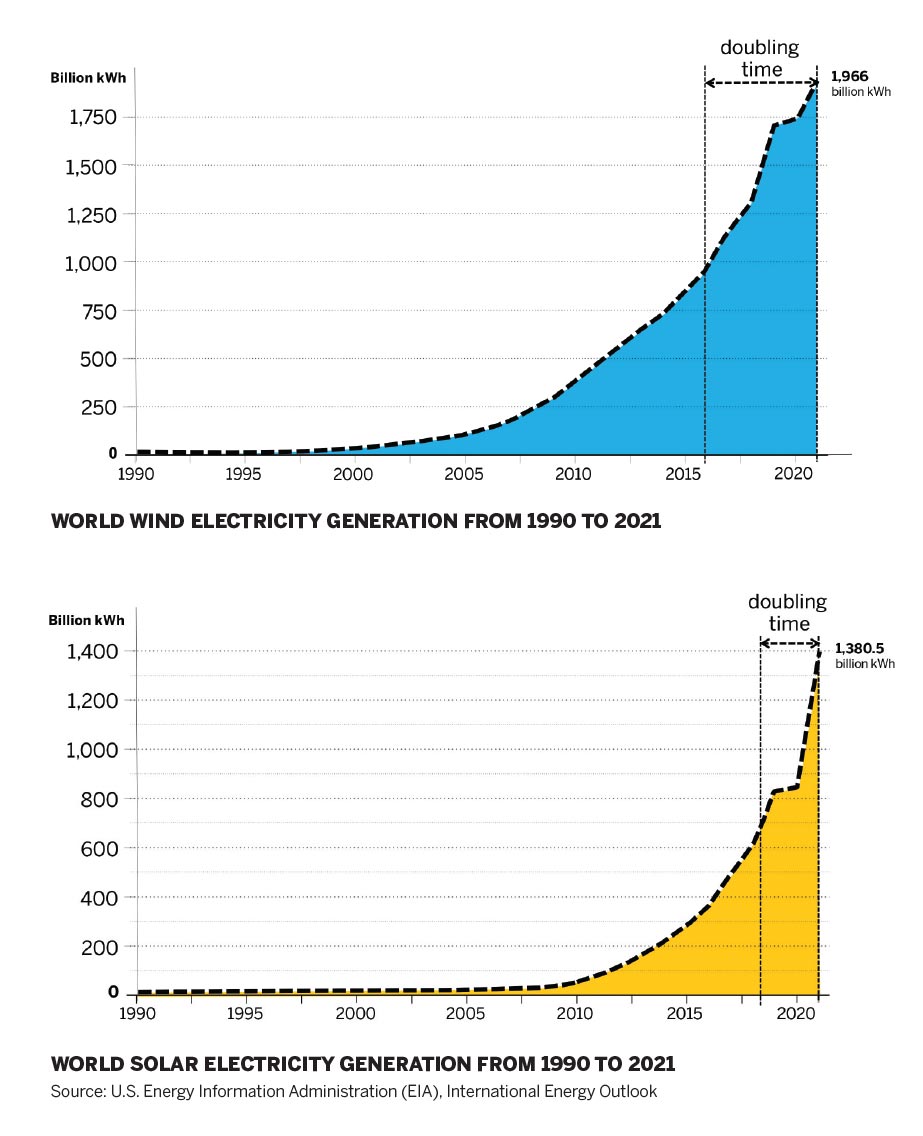
Photo courtesy of U.S. Energy Information Administration (EIA), International Energy Outlook World solar electricity generation from 1990 to 2021
The war in Ukraine has reminded us once again of the catastrophic security and humanitarian costs of fossil-fuel dependency. With Vladimir Putin using fossil fuels as a geopolitical weapon, the struggle in Ukraine, coupled with the climate crisis, has united the West around a struggle to rapidly wean ourselves off fossil fuels. A global transition to renewable-energy generation will dramatically reduce the power wielded by autocratic petrostates like Russia, whose economies are heavily dependent on the extraction and export of oil and natural gas.
In short, the renewables gambit is paying off. With an impressive foundation in place, now is the time to accelerate the transition to a zero-carbon built environment by implementing the following actions
- New Buildings—Adopt zero-carbon building codes, standards, and policies. This ensures that all new buildings are highly efficient, use no on-site fossil fuels, and generate or procure enough renewable energy to meet building demand.
- Existing Buildings—Enact policies that leverage building intervention points—or moments during a building’s life cycle when construction is likely to occur—in order to accelerate energy-efficiency upgrades, shift to electric or district heating systems powered by carbon-free renewable-energy sources, and generate or procure carbon-free renewable energy. Aligning work with these intervention points can help mitigate the cost barriers and disruption associated with renovations.
- Embodied Carbon—Enact policies and incentives that accelerate existing building reuse and renovation, use recycled and low-carbon or carbon-sequestering materials, design for deconstruction, and reduce emissions by designing carbon-sequestering sites and landscapes.
Implementing these policies will hasten the transition to renewable energy, building on the growth of renewable-energy generation and the recent movement toward electrification and reducing or sequestering carbon in the built environment. The present global crisis illustrates that doing so is an imperative, not a choice.
Edward Mazria, is the founder and CEO of the nonprofit Architecture 2030 and the 2021 AIA Gold Medal winner.
LEARNING OBJECTIVES
- Discuss how climate change disproportionately affects disadvantaged communities.
- Describe low-carbon solutions addressing the global housing crisis.
- Outline policy initiatives that encompass building decarbonization and social justice.
- Discuss worldwide trends in electricity generation.


